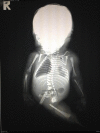Sirenomelia type VI (sympus apus) in one of dizygotic twins at Chiang Mai University Hospital
- PMID: 25976191
- PMCID: PMC4434282
- DOI: 10.1136/bcr-2014-208501
Sirenomelia type VI (sympus apus) in one of dizygotic twins at Chiang Mai University Hospital
Abstract
Those born with sirenomelia, a rare congenital anomaly, have features resembling a mermaid. Characteristics of sirenomelia are a single lower limb, sacral and pelvic bone defects, and anorectal and urogenital malformations. There is an increased incidence of sirenomelia in males and twins. This case was a preterm male, dizygotic twin and product of in vitro fertilisation. The baby was born by caesarean section due to breech presentation. He was found to have a fused lower extremity and absent external genitalia and anus. The baby passed away shortly after birth due to severe respiratory failure. Radiographic findings showed small lung volume and pneumothoraces. There were multiple segmental fusions of the vertebrae. Single femur and single tibia were presented in a fused lower limb. Autopsy demonstrated large intestinal atresia, intra-abdominal testes, absence of kidney, ureter and bladder, single umbilical artery, agenesis of blood vessels at lower extremity and agenesis of sacrum and coccyx.
2015 BMJ Publishing Group Ltd.
Figures



Similar articles
-
Sirenomelia in twin pregnancy: A case report and literature review.Medicine (Baltimore). 2018 Dec;97(51):e13672. doi: 10.1097/MD.0000000000013672. Medicine (Baltimore). 2018. PMID: 30572488 Free PMC article. Review.
-
Sirenomelia dipus in a dizygotic twin.Indian J Pediatr. 2002 Dec;69(12):1093-5. doi: 10.1007/BF02724397. Indian J Pediatr. 2002. PMID: 12557967
-
Sirenomelia apus with vestigial tail.Indian J Pediatr. 2005 Apr;72(4):367. Indian J Pediatr. 2005. PMID: 15876775
-
Six-month survival of a monochorionic monoamniotic twin with sirenomelia.Birth Defects Res. 2022 Nov 15;114(19):1286-1290. doi: 10.1002/bdr2.2016. Epub 2022 Apr 19. Birth Defects Res. 2022. PMID: 35437955
-
Sacrococcygeal dysgenesis association.Am J Med Genet. 1991 Nov 1;41(2):153-61. doi: 10.1002/ajmg.1320410203. Am J Med Genet. 1991. PMID: 1785625 Review.
Cited by
-
Successful Expectant Management of the Anomalous Fetus with Sirenomelia in Twin Pregnancy: A Case Report and Literature Review.Int Med Case Rep J. 2021 Apr 9;14:229-232. doi: 10.2147/IMCRJ.S300318. eCollection 2021. Int Med Case Rep J. 2021. PMID: 33859502 Free PMC article.
-
Sirenomelia in twin pregnancy: A case report and literature review.Medicine (Baltimore). 2018 Dec;97(51):e13672. doi: 10.1097/MD.0000000000013672. Medicine (Baltimore). 2018. PMID: 30572488 Free PMC article. Review.
-
Sirenomelia (Mermaid Syndrome): A Case Report.Turk Patoloji Derg. 2020;36(3):256-260. doi: 10.5146/tjpath.2020.01491. Turk Patoloji Derg. 2020. PMID: 32525213 Free PMC article.
-
Sirenomelia: A Case Report.JNMA J Nepal Med Assoc. 2018 Nov-Dec;56(214):974-976. doi: 10.31729/jnma.3884. JNMA J Nepal Med Assoc. 2018. PMID: 31065147 Free PMC article.
References
-
- Nisenblat V, Leibovitz Z, Paz B et al. . Dizygotic twin pregnancy discordant for sirenomelia. J Ultrasound Med 2007;26:97–103. - PubMed
Publication types
MeSH terms
LinkOut - more resources
Full Text Sources
Other Literature Sources
